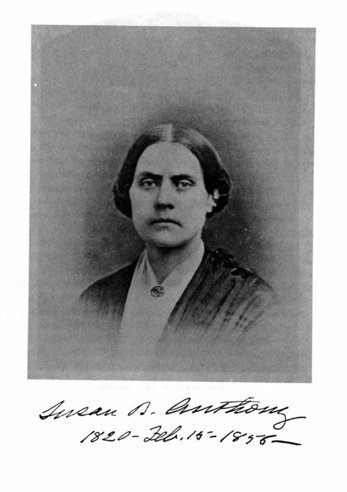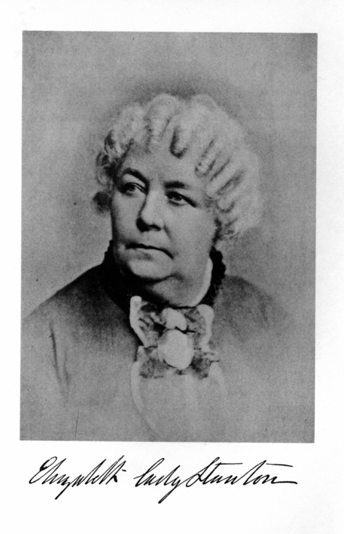As I am always searching for historical articles concerning anything having to do with the nineteenth century perspective on mental illness, insane asylums, the patients, and any one who may have been involved, I was very pleased to find this particular passage from Eighty Years And More: Reminiscences 1815-1897 by Elizabeth Cady Stanton (1815-1902), involving Susan Brownell Anthony. After reading it, I wanted to know the specifics of the story, and I had to find out who the characters were. Being a life-long resident of Rochester, New York, I am proud to say that Miss Anthony was also a resident of this fine city from 1866 to 1906. She is one of America’s most famous, beloved, and inspirational women because of her strength, dedication, and undying tenacity for the cause of women’s rights. Miss Anthony was born on February 15, 1820 in Adams, Massachusetts, and died on March 13, 1906 in Rochester, New York. Her most famous quote is, “Failure is Impossible.”
“While all this was going on publicly, an equally trying experience was progressing, day by day, behind the scenes. Miss Anthony had been instrumental in helping a much abused mother, with her child, to escape from a husband who had immured her in an insane asylum. The wife belonged to one of the first families of New York, her brother being a United States senator, and the husband, also, a man of position; a large circle of friends and acquaintances was interested in the result. Though she was incarcerated in an insane asylum for eighteen months, yet members of her own family again and again testified that she was not insane. Miss Anthony, knowing that she was not, and believing fully that the unhappy mother was the victim of a conspiracy, would not reveal her hiding place.
Knowing the confidence Miss Anthony felt in the wisdom of Mr. Garrison and Mr. Phillips, they were implored to use their influence with her to give up the fugitives. Letters and telegrams, persuasions, arguments, and warnings from Mr. Garrison, Mr. Phillips, and the Senator on the one side, and from Lydia Mott, Mrs. Elizabeth F. Ellet, and Abby Hopper Gibbons, on the other, poured in upon her, day after day; but Miss Anthony remained immovable, although she knew that she was defying and violating the law and might be arrested any moment on the platform. We had known so many aggravated cases of this kind that, in daily counsel, we resolved that this woman should not be recaptured if it were possible to prevent it.
To us it looked as imperative a duty to shield a sane mother, who had been torn from a family of little children and doomed to the companionship of lunatics, and to aid her in fleeing to a place of safety, as to help a fugitive from slavery to Canada. In both cases an unjust law was violated; in both cases the supposed owners of the victims were defied; hence, in point of law and morals, the act was the same in both cases. The result proved the wisdom of Miss Anthony’s decision, as all with whom Mrs. P. came in contact for years afterward, expressed the opinion that she was, and always had been, perfectly sane. Could the dark secrets of insane asylums be brought to light we should be shocked to know the great number of rebellious wives, sisters, and daughters who are thus sacrificed to false customs and barbarous laws made by men for women.” (1)
The following article is reprinted from The Model Editions Partnership Historical Editions in the Digital Age, The Papers of Elizabeth Cady Stanton and Susan B. Anthony, Copyright 1997. Rutgers University Press. All rights reserved.
“Phoebe Harris Phelps, wife of Charles Abner Phelps of Boston and the sister of prominent New York lawyers and politicians, approached SBA in Albany in December 1860 for help in her flight from her husband. On Christmas day SBA accompanied Phoebe Phelps and one daughter to New York City, where Abby Hopper Gibbons and the writer Elizabeth Ellet concealed the fugitives until they moved on to Philadelphia. Charles Phelps (1820-1902), who graduated from Union College in 1841 and Harvard Medical School in 1844, practiced medicine with his father. A successful political career began with election to the Massachusetts legislature in 1855. Meanwhile, his wife, who worked at the Albany Female Academy before her marriage, raised their three children and published several children’s books on religious themes. By her account, Charles Phelps became abusive and unfaithful before 1858, and when she confronted him, he committed her to the McLean Lunatic Asylum. After seventeen months of confinement, she got away to Albany. In one version she escaped; in another she was released to her brother’s home, and the flight to New York occurred after several months of disputes over visits with the children. In Philadelphia Phoebe Phelps supported herself by writing and sewing until, after ten months of safety, agents of her husband seized their daughter and returned her to Boston. Phoebe Phelps followed and with help from friends found a safe place from which to file for divorce. She published one more religious book in 1865. When Charles Phelps died in 1902, his obituary named his wife but said nothing more about her. Their daughters, both single, lived in Boston. SBA kept clippings about the case in her scrapbooks and identified the principals.” (2)
The following article is reprinted from Mothers on Trial: The Battle for Children and Custody by Phyllis Chesler.
“In 1860, the year Elizabeth Packard was psychiatrically imprisoned, Susan B. Anthony was visiting her friend Lydia Mott in Albany, New York. A disheveled and sobbing woman was admitted to the parlor. She was Mrs. Phelps, the wife of a Massachusetts state senator and a sister of a U.S. Senator. ‘Please won’t you help me? No one else will. I am a wife and mother. When I finally confronted my husband with proof of his adulteries, he beat me and had me put away in an Insane Asylum. My brother had me freed, but could not obtain permission for me to see my children. Yesterday, after a year, I was allowed to visit one child. I fled the state with her immediately. And now I am a fugitive.’
Anthony agreed to help Mrs. Phelps. She escorted her to New York City and obtained refuge for her there. State Senator Phelps threatened to have Anthony arrested during one of her public lectures. He also enlisted Anthony’s two most cherished abolitionist comrades, Garrison and Phillips, in his campaign against her.
Anthony’s comrades strongly believed that her action endangered the ‘women’s right’s movement and the anti-slavery cause.’ Anthony disagreed with them. She said, ‘Don’t you break the law every time you help a slave to Canada? Well the law which gives the father sole ownership of the children is just as wicked and I’ll break it just as quickly. You would die before you would deliver a slave to his master and I will die before I will give up the child to its father.’
Phelps hounded Anthony for more than a year. She remained firm. Finally, he hired detectives to locate his missing child. One Sunday morning, on her way to church, the young Miss Phelps was kidnapped on the street and ‘legally’ returned to her father.” (3)
Chapter XIII – Reforms and Mobs (Includes the origin of the word “bloomer”): Elizabeth Cady Stanton – Susan Brownell Anthony
SOURCES:
(1) Eighty Years And More: Reminiscences 1815-1897 by Elizabeth Cady Stanton (1815-1902) New York: T. Fisher Unwin, 1898, Chapter XIII. Reforms and Mobs.)
(2) The Papers of Elizabeth Cady Stanton and Susan B. Anthony, ed. Ann D. Gordon, et al. (Columbia, S.C.: Model Editions Partnership, 1999). Electronic version based on The Papers of Elizabeth Cady Stanton and Susan B. Anthony (New Brunswick, N.J.: Rutgers University Press, 1997) Vol. 1, pp. 196-461. On the Web at http://mep.blackmesatech.com/mep/ [Accessed 21 July 2012] Copyright 1997. Rutgers University Press. All rights reserved.
(3) Chesler, Phyllis, Mothers on Trial: The Battle for Children and Custody, Second Edition, Chicago Review Press, 2011, pages 7-8.
Susan Brownell Anthony Obituary – New York Times
National Susan B. Anthony Museum & House, 17 Madison Street, Rochester, NY 14608
Possible Grave of Phoebe Harris Phelps – Find A Grave
Ira Harris – Find A Grave
Ira Harris may be the brother of Phoebe Harris Phelps. Mr. Harris served as the Senator from New York from March 4, 1861 to March 4, 1867.
Corinthian Hall, Rochester, New York
Other articles concerning Dr. and Mrs. Phelps state that when Mrs. Phelps confronted Dr. Phelps about his adultery, he threw her down the stairs and beat her. When she threatened to tell authorities, he locked her up in an insane asylum and would not allow her to see her children. She remained in the asylum for eighteen months. Mrs. Phelps brother, the Senator from New York, freed her but could not get permission for her to see or have custody of her children. She was finally allowed to see one child, a daughter. Dr. Phelps was a member of the Massachusetts House of Representatives in 1856, and served as a State Senator in 1858. -L.S.Stuhler




Pingback: E.P.W. Packard… and Susan B. Anthony?: A connection on paper | Packed with Packards!
Pingback: Rochester State Hospital & Mt. Hope Cemetery | The Inmates of Willard 1870 to 1900 / A Genealogy Resource
I am descended from Senator Ira Harris brother Henry. Yes, Phoebe was their sister. Amazing story what she went through. I’ve had the family genealogy for years and never noticed Phoebe before. And to think she was a writer like I am.
LikeLike
Thanks for writing, Susan! Interesting story!!
LikeLike
Do you think there are any records pertaining to Phoebe’s time at Willard? I can’t even imagine what it was like for her. Too bad that creep of a husband outlived her by three years. She died just two years after my grandfather John Henry Harris was born — and he lived to a very ripe old age so I was blessed to have known him well. Nowadays it’s hard to convince people you knew someone who was born in 1887!
LikeLike
I know what you mean! My grandfather was born in 1878, died in 1972. I don’t think she was at Willard. I wrote that a while ago and can’t remember. I have a feeling she was at the asylum in NYC. I will have to double check. You may be able to find her in a federal census record depending on how long she was there. My great-grandmother was at Willard after 1920 and died before 1930, so she does not show up on the census. Thanks so much for writing and let me know if I can help! -Lin
LikeLike
I highly recommend you add The Yellow Wallpaper by Charlotte Perkins Gilman to your reading list if you have not read it already. It is a short story and available online so anyone with internet access can read it.
LikeLike
Thanks! I will check it out.
LikeLike
Mankind, the most unkind of all species. Well, and politicians, the un-kinder.
LikeLike
I don’t believe that all mankind is unkind, but there are and always will be cruel individuals.
LikeLike